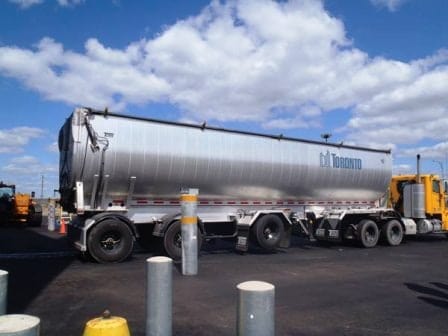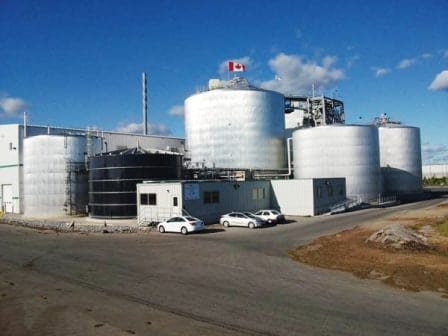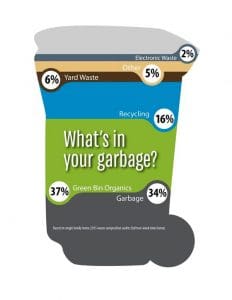With a commitment to improving waste reduction and diversion efforts to move towards the goal of achieving 70 percent waste diversion, the City of Toronto has a mission to be a leader in providing innovative waste management services to residents, businesses and visitors.
Toronto is Canada’s largest city, the fourth largest in North America, and home to a diverse population of about 2.8 million people. It is a global center for business, finance, arts and culture and is consistently ranked one of the world’s most livable cities.
Toronto’s Solid Waste Management Services Division (SWMS), one of the largest municipal solid waste management operations in North America, is responsible for collecting, transporting, processing, composting and disposing of municipal and some private sector waste. This includes garbage, Blue Bin recyclables, Green Bin organics, yard waste, oversized and metal items, as well as household hazardous waste and electronic waste.
SWMS oversees a comprehensive waste management system that includes providing support and services from the initial generation of waste (or avoidance of generation) through to the monitoring of closed landfill sites, long after the final residual waste has been disposed and the site has been closed. This system comprises a network of programs, services, truck fleets, transfer and drop-off facilities, processing facilities, and residual management facilities providing services to a wide range of customers. It is financially supported through a number of funding and revenue sources.
SWMS operates seven transfer stations, which have drop-off depots used to collect, sort and transfer all of the City’s waste, two anaerobic digestion facilities, a reuse center, four collection yards, one litter collection yard and more than 600 vehicles and pieces of equipment, in addition to one active landfill site and providing perpetual care for 160 closed landfill sites.
Innovative Waste Management Services
SWMS’ mission is to be a leader in providing innovative waste management services to residents, businesses and visitors within the City of Toronto in a safe, efficient, effective and courteous manner, creating environmental sustainability, promoting diversion and maintaining a clean city.
The City is committed to improving waste reduction and diversion efforts to move towards the goal of achieving 70 percent waste diversion, which will preserve the capacity of the Green Lane Landfill and secure the City’s long term disposal requirements. In 2015, a total of 405,392 metric tonnes1 of residential waste was diverted from the landfill through such programs as the Blue Bin recycling, Green Bin organics, yard waste and Christmas trees, backyard composting, Community Environment Days, household hazardous waste, grass cycling, large appliance/scrap metal and electronic waste pick-up.

“With the recent approval of our Long Term Waste Management Strategy, SWMS will work towards a circular economy and zero waste future, which will be measured by a new key performance indicator: waste generation rate per capita,” says Jim McKay, General Manager, Solid Waste Management Services, City of Toronto. “A circular economy shifts the way waste management is viewed and approached, looking to prevent waste generation and maximize resource recovery.”
Efficient and Effective Service Delivery
SWMS has more than 1,100 employees across four sections:
Collections & Litter Operations
This section provides collection of garbage, Blue Bin recycling, Green Bin organics, yard waste, over-sized and metal goods for single family homes, multi-residential properties, non-residential customers (e.g. charities), the City’s divisions, agencies and corporations, institutions and small commercial establishments.

It also provides litter cleaning operations on boulevards, sidewalks and dedicated bicycle lanes across Toronto, and services litter receptacles throughout the City’s streets and parks, as well as provides services to Special Events and Community Environment Day Events across Toronto. The “Customer Service and Waste Diversion Implementation” unit in this section gives support for SWMS in its goal of improving customer service and implementing new waste diversion initiatives.
Collections & Litter Operations services approximately 1 million homes and businesses, including:
461,000 single family residential
416,000 multi-residential units (apartments and condominiums)
12,000 residential units above commercial (RUAC)
14,500 small commercial establishments
It maintains and collects from:
Approximately 8,700 street litter/recycling bins
10,000 bins in public parks
1,000 special events per year
City divisions, agencies and corporations
Non-profits (charities, institutions and religious organizations)
Schools (elementary and secondary)
Private industrial, commercial and institutional waste is also accepted at Toronto’s drop-off depots and landfill
Infrastructure Development & Asset Management (ID&AM)
ID&AM is responsible for the Division’s physical assets throughout their complete lifecycle, from initial design and construction to commissioning and start-up, and meeting major maintenance and rehabilitation requirements to the eventual retirement and disposal of the asset. ID&AM oversees roughly $600 (CDN) million in assets including more than 600 fleet assets and more than 1.5 million bins and carts. This area of SWMS has four units:

Asset Management supports SWMS through the development and implementation of asset management and capital plans for the rehabilitation and replacement of assets in order to maintain service levels, minimize risks and optimize decision-making processes.
Capital Delivery is responsible for the implementation of capital projects including the engineering, design, permitting, tendering, construction and commissioning of major repairs, replacements, upgrades and expansions for existing facilities, as well as the development of any new infrastructure for the Division.
Closed Landfill Operations maintains all of the City’s closed landfills requiring perpetual care. This includes the maintenance of engineered systems and the monitoring and reporting on various parameters including surface/groundwater analysis and landfill gas collection and management. In addition, they support the Division by assisting in the development of landfill gas use strategies as well as new and innovative approaches for future uses of closed landfill sites.
Facilities & Equipment Maintenance is responsible for maintaining all of the Division’s assets ensuring an overall state of good repair, thereby leading to safe and effective operations.
Policy, Planning and Support (PP&S)
This section of SWMS is responsible for monitoring trends in the solid waste industry and providing policy and planning advice on new programs, program enhancements and new technologies to the Division’s operating units and Toronto City Council. It provides technical review and comments on internal and external regulations, legislation, statutes and policies.
It researches, designs and drafts integrated programs, policies, eligibility criteria and bylaws to support operations as well as designing and executing Request for Proposals and Tenders for materials and services. In addition to coordinating the development and submission of the operating and capital budgets, this section monitors and reports on budget variances, provides analytical support on financial issues and executes administrative support for the Division’s contracts and agreements.
PP&S is also responsible for the effective planning, organizing, management and control of residential programs and services related to the billing, revenues and accounting of the SWMS rates.
Processing & Resource Management (P&RM)
P&RM is responsible for the management and processing of all recycling, organics and garbage from the City’s collection programs. The section operates the Division’s transfer stations, hazardous waste and electronic waste depots, re-use center, organics processing facilities and the Green Lane Landfill. The City’s network of seven transfer stations are strategically located across Toronto allowing collection vehicles to empty close to the source of the waste collected. This improves efficiencies and reduces operating costs, while reducing the environmental impact by having collection vehicles travel shorter distances.
The recycling and organic materials collected at the transfer stations are transferred by city operated tractor trailers to various processing facilities and the garbage is transferred for disposal at the Green Lane Landfill.
One of Toronto’s organics processing facility is located at the Disco Transfer Station and is designed to process 75,000 metric tonnes of source separated organics (SSO) per year. The second organics processing facility, located at the Dufferin Transfer station, is currently undergoing an expansion incorporating new technologies, which will process an additional 55,000 metric tonnes per year.
Processing & Resource Management is also responsible for the sale of recyclable materials generating revenues that offset some of the processing costs.
Internal Operations
 Health and safety is always a top priority and Toronto is committed to providing and maintaining safe and healthy working conditions for all members of the Toronto Public Service. SWMS abides by the Ontario Occupational Health and Safety Act (OHSA), which sets out the rights and duties of workers, supervisors and employers in keeping workplaces safe and healthy in provincially regulated workplaces.
Health and safety is always a top priority and Toronto is committed to providing and maintaining safe and healthy working conditions for all members of the Toronto Public Service. SWMS abides by the Ontario Occupational Health and Safety Act (OHSA), which sets out the rights and duties of workers, supervisors and employers in keeping workplaces safe and healthy in provincially regulated workplaces.
Employees have the right to know about hazards in the workplace and are trained on how to protect themselves from harm. As of July 1, 2014, the law requires employers to make sure that all of their workers and supervisors have completed basic health and safety awareness training. This training outlines workers’, supervisors’ and employers’ rights, roles and responsibilities in keeping workplaces safe and healthy. SWMS also encourages employees to help identify and resolve workplace health and safety concerns.
In 2014, the City of Toronto engaged an independent consultant to review SWMS’ current collection and operational practices to identify potential areas for improvement and provide recommendations in a final report for additional safeguards to public safety. They reviewed:
Waste collection operations provided by City staff and contracted staff
Routing of collection vehicles and equipment
Operator training
Vehicles and equipment design
Over the last two years, SWMS has been implementing the recommendations from this report. This includes working with other City divisions to seek additional data to allow for more detailed accident analysis, improved investigations and root cause analysis; educational outreach to the community and schools and regular reviews and updates (where necessary) of standard working procedures.
SWMS also works with Toronto’s Fleet Services to ensure its employees are trained on City vehicles and equipment, including:
Inspecting, testing and maintaining vehicles and equipment
Administrating the vehicle and equipment replacement program
Training and licensing drivers and operators of City vehicles and equipment
Administrating and monitoring services provided through external suppliers
Keeping complete operating and maintenance records for each item in the fleet
Managing vehicles and equipment (acquisition and disposal)
Managing fuel site operations and supply of fuel from internal and commercial sites
Ensuring compliance with the provisions of the Highway Traffic Act
Ensuring safe fleet operations through equipment operator and related training
Establishing guidelines for safe driver operations
From Simple Collection to a Complex Management System
Waste management programs in the City of Toronto have evolved from simple garbage collection to a complex system of collecting source separated materials including Blue Bin recycling, Green Bin organics, garbage, bulky goods, electronic and household hazardous waste, as well as a range of other specific items.
 Among the challenges facing SWMS are Toronto’s extensive growth over the last number of years (which requires continued investment and expansion of current infrastructure), reduced commodity markets (resulting in less revenue and requiring a corresponding increase in rates to offset losses), and packaging changes (which has resulted in greater volumes being managed but lower tonnages requiring a need to modify performance metrics).
Among the challenges facing SWMS are Toronto’s extensive growth over the last number of years (which requires continued investment and expansion of current infrastructure), reduced commodity markets (resulting in less revenue and requiring a corresponding increase in rates to offset losses), and packaging changes (which has resulted in greater volumes being managed but lower tonnages requiring a need to modify performance metrics).
The biggest challenge facing SWMS today is waste diversion in multi-residential buildings. “In Toronto, almost half of the population live in apartments, condominiums and some type of townhouses. However, the diversion rate for multi-unit properties falls significantly behind the diversion rate in single-family homes,” explains McKay.
In 2015, residents living in single-family homes had a diversion rate of 65 percent, while residents in multi-unit buildings achieved a rate of 27 percent. As a result, SWMS implemented the Customer Service and Waste Diversion Implementation team to help multi-residential properties improve their waste diversion, invested in public education campaigns and tools for buildings to help educate their residents, and assisted buildings with programs like the 3Rs Ambassador Program—an education and outreach program, using resident volunteers, to help people living in apartments and condos to reduce, reuse and recycle more.
Another current challenge for SWMS is contamination in the waste stream. Currently, Toronto sells recyclable materials to various markets and processors. The Material Recovery Facility (MRF) can separate some contamination, but there is a functional limit to the amount it can remove. Too much contamination can cause processors to reject whole loads of otherwise good recyclable material.
“Removing contaminated materials from recyclable materials at the MRF drives up processing costs because the higher the contamination rate, the higher the processing fees the City must pay,” says McKay. “Not only can loads that exceed an accepted level of contamination end up in landfill, but there could also be increased costs for solid waste, which, in turn, could result in higher costs for residents.”
In 2015, about 44,000 metric tonnes of garbage/organics mixed with recycling was processed/handled at the MRF. This represents approximately 25 percent of the total inbound recyclable waste stream. Waste audits showed that the most common contamination in recycling are:
Organic material (meat, bread, fruits and vegetables)
Textiles—clothes, shoes, curtains
Hoses, cords and cables
Plastic items such as toys, black plastic, squeeze tubes
Propane tanks and cylinders
Containers with food residue
Coffee cups
Medical waste and needles
Incorrect items in recycling can also cause workplace injury (e.g. propane tanks or other canisters explode under pressure) and/or damage equipment (e.g. hoses, cables and textiles get caught in machinery). To combat this issue, SWMS has implemented various tactics including public education campaigns, spot checks, site visits and issuance of fines.
Outstanding Programs
SWMS is proud of the comprehensive programs that it has implemented into its operations over the last several years, leading to increased waste diversion and innovative ways to face ongoing challenges.
Asset Management Framework
Solid Waste Management Services is one of the first divisions in the City of Toronto to develop and implement an Asset Management Framework and one of very few municipalities globally to take the holistic asset management approach. SWMS is implementing the asset management framework across the Division to support an optimized decision making process for its physical assets while managing risks and optimizing cost.
Environmental Initiatives
SWMS is in a unique position to contribute positive change towards the City of Toronto’s greenhouse gas (GHG) reduction targets through a variety of innovative projects. One example of this is converting their solid waste diesel collection fleet to run on compressed natural gas (CNG). CNG is a more environmentally friendly fuel source than either diesel or gasoline, and emits about 25 percent less GHGs when compared directly to diesel collection trucks. In addition, CNG trucks reduce other harmful emissions such as particulate matter, which can cause significant adverse effects to human health. CNG trucks are also far quieter than their diesel counterparts, leading to decreased levels of local noise pollution and better operating conditions for solid waste staff.
The Disco Road Organics Processing Facility (DROPF) is North America’s first full-scale municipal source separated organic (SSO)/Green Bin waste processing operation to use anaerobic digestion. Using anaerobic digestion to process organic material produces biogas, which is made up of about 70 percent methane and 30 percent carbon dioxide. One very promising concept, early in the development stage, is to use renewable natural gas (RNG) to create a closed-loop approach where the organic material produced by residents is collected, processed, and then used to fuel the SWMS collection fleet. To put the amount of fuel that can be produced in context, the DROPF can produce about 4 million diesel liter equivalents annually.
Bin Program
Over 25 years ago, Toronto introduced the City’s first curbside recycling container, the Blue Bin. Today, more than 96 percent of Toronto’s single-family homes participate in the Blue Bin Program and about 89 percent participate in the Green Bin organics program. With all of Toronto’s collection programs and new materials being regularly added to the list of recyclables, many houses now put out less garbage than ever before.
Innovative Public Education and Stakeholder Outreach
SWMS prides itself on developing unique and effective communications to the residents, businesses, visitors, agencies and corporations on how to participate in the City’s waste management programs and encourage diversion. In 2016, SWMS committed approximately $3.6 million (CDN) towards various communication initiatives including: advertising and promotion, development of information materials, stakeholder consultation, Web site and social media content, ethno-racial outreach and events.
Looking at Long Term Waste Management in Toronto
In 2007, Toronto City Council approved a waste diversion plan that outlined a 10-year strategy to achieve the goal of 70 percent diversion by 2010. However, in 2013 SWMS reported back that the 70 percent diversion target had not yet been reached due to various factors. To resolve this, SWMS has worked over the last two years to develop a new waste strategy to meet the City’s waste diversion goals.
In July 2016, Toronto City Council approved the Long Term Waste Management Strategy—a comprehensive strategy which will guide waste management in Toronto for the next 30 to 50 years. “The new waste Strategy puts priority on reducing waste and minimizing the amount sent to landfill. It emphasizes the importance of community engagement and encourages prevention of waste, maximizing its value before disposal,” says McKay.
The Strategy recommends waste reduction, reuse, recycling, recovery and residual disposal policies and programs that are cost-effective, socially acceptable and environmentally sustainable for the long term, with a goal of maximizing the life of the Green Lane Landfill. SWMS will focus on eight guiding principles developed to support decision making in the future as the Long Term Waste Management Strategy is implemented:
Prioritizing the waste hierarchy through reduction, reuse and recycling
Leveraging programs and services already in place in order to further improve waste diversion potential
Waste strategy options for multi-residential buildings
Strategic system planning to minimize the need for new capital infrastructure investments
Working together with community partners to enhance access to diversion programs, collaborate in service delivery and increase citizen engagement to support sustainable solid waste management practices
Maintaining flexibility for future changes to the waste management landscape
Service, stewardship and commitment in continuing to deliver high quality and cost effective customer service for waste management programs
Minimizing wasted resources
Toronto’s Solid Waste Management Services will continue to promote and exemplify the vision outlined in the Long Term Waste Management Strategy: “Together we will reduce the amount of waste we generate, reuse what we can, and recycle and recover the remaining resources to reinvest back into the economy. We will embrace a waste management system that is user-friendly, with programs and facilities that balance the needs of the community and the environment with long-term financial sustainability. Together, we will ensure a safe, clean, beautiful and healthy city for the future.”
For more information, contact Jim McKay, General Manager, Solid Waste Management Services, City of Toronto at [email protected].
Note
1 metric tonne = 1.10 U.S. tons or 2204.62 lbs
